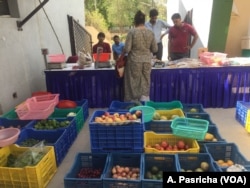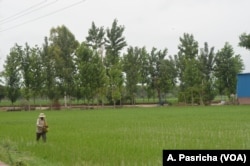They were no common protests. As angry farmers dumped milk and vegetables on the streets in India’s western Maharashtra state and six farmers were killed by police in Madhya Pradesh state when they blocked roads and burnt vehicles, the spotlight has turned on growing rural distress in the country.
The protests flared unexpectedly when bumper harvests following a good monsoon were supposed to augur well for rural prosperity.
But the opposite has happened: a price crash due to the crop glut not just wiped away any prospect of a profit but left farmers struggling to pay back loans which they often raise to buy seeds, fertilizers and other inputs to plant crops.
Low crop prices
The violence witnessed last week was a rare eruption of anger in the rural community in a country whose economy is the world’s fastest-growing, but where tens of millions of farmers are coping with stagnating incomes as they struggle to make a living off small land holdings.
Experts say decades of neglect in crucial infrastructure in the farm sector has left behind India’s countryside. With no easy access to markets close to villages and few storage facilities, farmers say they are at the mercy of traders and middlemen who often do not give them a fair price for their produce.
“The farmer does not have the right to set the price. It is the middlemen who set the price. They buy my produce for Rs 10 per kilo and sell it for Rs. 20 or 30 to customers. This is a major problem in the country,” lamented Bhim Singh, a farmer in northern India. “There should be better marketing platforms for us.”
Once a week, he makes an 80 kilometer trip to Gurugram, a flourishing business hub near the capital New Delhi, where he sells directly to consumers to get a better price. But he says he is forced to dump the rest in a wholesale market for prices that barely cover his cost of cultivation.
Farmers always seem to suffer
“There is a strong pro-consumer bias in the system,” said agriculture economist Ashok Gulati at the Indian Council for Research on International Economic Relations in New Delhi. “When there is a drought, as there was in 2014 and 2015, farmers suffer as production drops, and when there is a good harvest they suffer again as prices crash in the absence of commensurate storage and processing facilities or due to export restrictions.”
Rural experts have long urged the government to build more roads and markets closer to villages and storage facilities that will make it possible for them to sell produce at better prices when there is a bumper crop instead of resorting to distress sales as has happened this year.
Better roads and storage facilities needed
In fact, although food production has increased steadily in India making it self-sufficient, farmers incomes have lagged behind. New Delhi based agriculture expert Devender Sharma pointed out the average income of a farmer in 17 states, as per the government’s 2016 economic survey, is a meager Rs. 20,000 (about $300) per year.
“The real income of farmers is static for last 25 years. There is something terribly, terribly going wrong… he requirement is overhaul of agriculture policies. We need to give farmers his due income,” he points out.
Too many farmers
The low incomes are not surprising — too many people depend on agriculture for a living. Farming accounts for just 15 per cent of the country’s gross domestic product, but it supports more than half the country’s 1.3 billion people.
In a cover story this month, a leading news magazine, India Today, called India “No country for Farmers” and said the country “desperately needs another revolution in agriculture for the farmer to break out of his vicious cycle of misery.”
Reports of farmers committing suicide because they cannot repay their loans come in with alarming regularity.
Farmer Bhim Singh testified to the sense of despondency in his community. “My children don’t want to go into farming. They say they will toil as labor, work in factories, but they will not farm.”
State takes action after protests
In the wake of protests by farmers in Maharashtra and Madhya Pradesh, the state governments have promised to write off bank loans and ensure farmers get better prices for their crops. In the northern Uttar Pradesh state, where elections were held earlier this year, the government has also promised to write off loans.
But this has triggered even greater anger among farmers in the rest of the country, said chief adviser to the Consortium of Indian Farmers Association, P. Chengal Reddy.
Disappointment with new prime minister
He said farmers had pinned high hopes on Prime Minister Narendra Modi, who had promised to address their problems when he was voted to office three years ago and has pledged to double farm incomes by 2022.
But farmers feel let down because on the ground nothing has changed. And the crash in prices of farm produce this year was for many he says “the last straw.”
“The dichotomy of India is that Indian agriculture is successful but farmers are angry, annoyed, disgusted, unhappy,” Reddy warned. “This [dumping of] vegetables and milk is only a beginning.”












